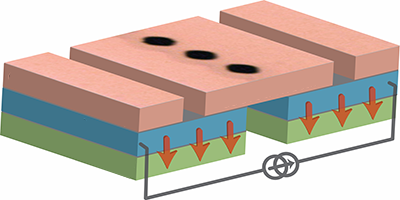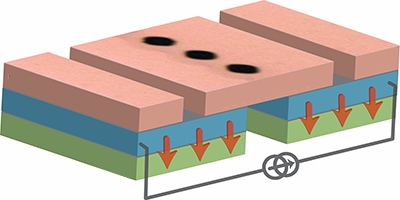The Coolest Microfridge
Cutting-edge electronic cooling devices work by having hot electrons tunnel from a metal to a superconductor, carrying heat with them. A new design, which has a “drain” for removing hot particles in the superconductor, has cooled a micrometer-sized metal slab from millikelvin (mK) to a record temperature of less than mK. Devices based on this scheme could potentially be installed directly on a chip for cooling qubits or ultrasensitive low-temperature detectors.
The basic structure in these electronic coolers consists of two NIS (normal metal-insulator-superconductor) junctions. When voltage is applied, relatively high-energy (hot) electrons flow out of the metal and into one superconductor, while lower-energy (cooler) electrons flow in from a second superconductor. Using this technique, previous work has been able to cool a small metal piece from to mK. However, the scheme’s cooling potential is diminished by heat leaking back into the metal, in particular, from hot “quasiparticles” (electron-hole pairs) that reside in the superconductors.
Jukka Pekola of Aalto University School of Science, Finland, and his colleagues explored different ways to reduce heat leakage in their aluminum-based cooling devices. First, they isolated the metal from the device substrate by placing it on top of the superconductor leads. Second, they connected each superconductor to a metal (aluminum-manganese) strip, acting as a quasiparticle drain. If a hot quasiparticle enters the drain, it rapidly loses its heat to phonons in the crystal. Thanks to this heat draining, the team’s cooling devices not only go to lower temperatures but also have much higher cooling power (heat removed per time) than other designs.
–Michael Schirber
This research is published in Physical Review Applied.





